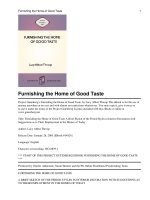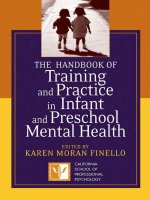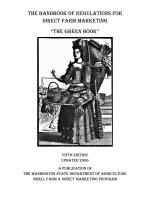The Handbook of Good English
Bạn đang xem bản rút gọn của tài liệu. Xem và tải ngay bản đầy đủ của tài liệu tại đây (7.29 MB, 447 trang )
THE
HANDBOOK
OF
GOOD
ENGLISH
THE
HANDBOOK
OF
GOOD
ENGLISH
REVISED AND UPDATED
s
Edward D. Johnson
B
EactsQnFik
New York • Oxford
The Handbook of Good English: Revised and Updated
Copyright © 1983, 1991 by Edward D. Johnson
All rights reserved. No part of this book may be reproduced or utilized in
any form or by any means, electronic or mechanical, including photocopying,
recording, or by any information storage or retrieval systems, without permission
in writing from the publisher. For information contact:
Facts On File, Inc.
460 Park Avenue South
New York NY 10016
USA
Facts On File Limited
Collins Street
Oxford OX4 1XJ
United Kingdom
First published as The Washington Square Press Handbook of
Good English by Pocket Books, a Simon & Schuster division of
Gulf & Western Corporation, 1230 Avenue of the Americas,
New York, N.Y. 10020
Library of Congress Catalog Card Number: 91-21872
A British CIP catalog record for this book is available from the British Library.
Facts On File books are available at special discounts when purchased in bulk quantities
for businesses, associations, institutions or sales promotions. Please call our Special Sales
Department in New York at 212-683-2244 (dial 800\322-8755 except in NY, AK or HI) or
in Oxford at 865/728399.
Manufactured by the Maple-Vail Book Manufacturing Group
Printed in the United States of America
10 9 8 7 6 5 4 3 2
This book is printed on acid-free paper.
<*
CONTENTS
k>
PREFACE
1
vii
1
The Sentence
Case of Nouns and Pronouns: Subjective,
Objective, and Possessive
Agreement
Verb Tenses: Past, Present, and Future
Verb Moods: Indicative, Imperative, and
Subjunctive
Verb Voices: Active and Passive
Modifiers
2
GRAMMAR
3
PUNCTUATION
Sentence Structure
Comma
Semicolon
Colon
Dash
Parentheses and Brackets
Question Mark
Exclamation Point
Quotation Marks
Points of Ellipsis
Apostrophe
Hyphen
Diagonal
20
32
48
58
63
65
81
83
94
121
125
131
136
143
149
151
166
172
182
216
•
Contents
HOW TO STYLE WRITTEN
ENGLISH: MISCELLANEOUS
MECHANICS
Numbers
Dates
Abbreviations
Generic Terms
Titles of Officials and Names of Their Offices
Forms of Address
Place-names
Titles of Publications and Works of Literature,
Works of Art, Musical Compositions, and
Other Works
Foreign Words
219
222
228
229
232
234
238
241
245
256
BEYOND THE SENTENCE: DICTION
AND COMPOSITION
26i_
Occasion and Intent
Organization
Tone
Revision
GLOSSARY / INDEX
262
267
271
278
293
<^
PREFACE
K>
This book's first edition was published in 1982. Only seven
years later I decided to revise it, but not because I thought it
had so quickly become out of date. It was based on more than
twenty years of experience as a book editor and more than half
a life spent largely in well-spoken company and I didn't think
either it or I was substantially dated. I was aware of some new
uses and misuses of the language and wanted to comment on
them, but my primary intent was to rectify shortcomings that
had been exposed by seven years of testing the book against
writing I had edited or read for pleasure and speech I had heard.
I wanted to expand my discussions of many details, modify my
judgments on a few matters, increase the number of crossreferences, and enlarge the Glossary/Index—all of which I have
done.
In the course of the revision, however, I discovered that
English and attitudes toward it have changed more than I had
thought, and that I have changed too.
For one thing, the language has made adjustments to complaints that it is sexist, and it continues to adjust. I discuss this
change and my accommodations to it under sexism in the
Glossary/Index; it has affected the diction in this revision
considerably. In 1982, I think, avoidance of sexist diction
would have weakened my book for many readers, but now,
sexist diction would weaken it, because genderless expressions
that once were evasive and obtrusive have become straightforward and unsurprising.
Another change—perhaps it is partly an effect of the swift
and broad acceptance of nonsexist alternatives to traditional
diction, which has demonstrated the adaptability of English—
is an increasing awareness among those interested in language
and correct use of it that correct is not always easy to define. In
the 1970s, several widely read writers on language came down
vii
•
Preface
heavily on usages and constructions that they considered debased, inane, despicable—and these writers' readers tended to
accept such condemnations humbly, even guiltily As the 1980s
began, so did an antithesis in popular writing on language. The
best-selling "prescriptivists" of a few years before were rebuked
for their bad temper and often jeered at for their bad scholarship. The "permissivists" insisted that English was what it
was and would change as it would.
Now we are perhaps in a lull in the war between prescriptivists and permissivists—or in a battle of that war. The war
has been going on for centuries, and the current battle may
have been evident in the broad world of letters only in the past
decade but has been in progress in smaller arenas for some
time, certainly since the publication of Webster's Third New
International Dictionary in 1961 (an event discussed under
usage in the Glossary/Index). But if there is a lull, nevertheless
consciousness has been raised. The broad writing, speaking,
and reading public is now not so easily cowed.
The first edition of this book—though ''strict," which is to
say prescriptive—was considerably more genial in tone than
many similar books of its time, and, unusual for prescriptive
books, it did its best to explain its prescriptions or admitted
that there was no explanation but convention. However, it took
it for granted that any reader consulting it would share its
author's belief that there was such a thing as "good English"
and that it was worth learning.
The present edition is as strict as the first. It assumes that
those who use it want to be protected from criticism—and
there are still plenty of critics. The general culture may have
become more permissive about language, but that does not
mean there are no more critics; in fact, the polarizing effect of
the prescriptivist-permissivist battle has probably both increased their number and hardened their opinions. And—in my
view—a great many of their opinions remain right, if there is
such a thing as good English.
This edition does, however, take even more pains than the
first to explain its rules and to distinguish logic from tradition,
tradition from prejudice, prejudice from common sense, common sense from nonsense. It is more thoughtful and, I hope,
wiser; it has been through the battle. And as its author, I feel
obliged, as I did not in 1982, to explain at some length what I
mean by good English, why I feel qualified to expound on its
strictures, and why I believe learning those strictures is worthwhile.
viii
Preface
•
Good English changes over the course of time, and at any
given time there is some disagreement about what it is, both as
a concept and as an accumulation of usage details. I begin my
definition with a statement that may be self-evident but should
make it clear that the advice in this book, though "strict," is
not based on absolute truths: Good English is English that at
present very rarely sparks the expressed or unexpressed reaction "That's not good English/' either from those who really do
know better or from those who merely think they do. I say
"very rarely" rather than "never" because usage arbiters don't
always agree, and also because critical reactions of two kinds
cannot be avoided. On the one hand, the reactions of those who
know almost nothing can be entirely wrongheaded and must
sometimes be ignored. For example, I have been criticized for
saying between her and me on the ground that between she
and 1 is more elegant—but elegant or not, and I say decidedly
not, between she and I is wrong. On the other hand, the
reactions of those who know almost everything, the true, and
few, serious scholars of language and usage, can be excessively
rightheaded. For example, careful avoidance of plural pronouns
such as their after singular pronouns such as everyone is justly
criticized by the truly knowledgeable as a rejection of a natural
usage that has been common in the best literature for centuries. But a much larger minority, those who are not scholars
but do in general "know better," reject the usage, so I think we
must reject it too.
To continue my definition, good English is a kind of snobbery. It is not standard English but the English of a minority
who are likely to consider themselves superior, and are also
likely to be considered superior by others. English that is good
enough in one context may not be good enough in another, and
thus good English amounts to savoir faire, a touchstone of the
snob. All of us fail to use it occasionally, and some of us fail to
use it frequently. Those who fail infrequently look down on
those who fail frequently; those who fail frequently either live
in constant fear of embarrassing themselves or find some way
of taking pride in their unvarnished expression. Those who fail
infrequently make further distinctions among themselves; the
famous grammarian H. W Fowler observed, "Almost every man
is potentially a purist and a sloven at once to persons looking at
him from a lower and a higher position . . . than his own."
Grammar and usage are therefore touchy subjects, like class
distinctions—they are class distinctions. We expect occasional
correction from a parent or teacher, but any friend who corix
•
Preface
rects us had better be a good friend indeed; he or she is implicitly criticizing our background, our education, our place in
the world, our being. And though many of the strictures of
good English promote clear expression and clear thought,
many others are merely the prejudices of language snobs. Consequently, those of "good" background are frequently in a position to criticize a speaker or writer who has not snared their
advantages but may have superior intelligence and superior
overall command of English. Such criticism is unfair and undemocratic, but also far from uncommon; it is simply a fact of
society. In this book I usually identify strictures that are prejudices, and so readers who are not snobs and are immune to
snobbery can choose to ignore them—but I think few of us are
entirely unsnobbish or entirely immune to snobbery; I am not.
Longtime editors like me are, however, at least relatively free
of language snobbery. We spend our days and years correcting
the written expression of others, some of whom we are forced
to recognize as more intelligent, more highly educated, more
sophisticated both socially and verbally, and more successful
than we are, and unless we are unusually ill-natured we eventually are led to admit to ourselves that our skill is a humble
one and that those we correct often have much more to express
than we do and often express it with much more flair than we
could. We allow superior writers many liberties. It is likely that
every so often we have been slapped down by such writers for
making ill-considered changes, and we have learned from our
humiliations. We have a massive armament of arbitrary prescriptions and niceties, but we bring the big guns to bear
chiefly on mediocre and bad writing—which improves markedly when so attacked, partly because editorial routines often
expose faulty thought, which can then be attended to; our
skills do have an important function in this wordy world.
We find it difficult to explain our weathered, dispassionate,
and sometimes permissive attitude to friends who think we
should be "guardians" of the language, and who may use English carefully and well but resist its natural evolutions and
hold passionately to usage prejudices that they cannot justify.
We do very often impose such prejudices on what we edit, since
we want to protect those we edit from criticism both rightheaded and wrongheaded, but we may not share them. We
know the rules, we know the prejudices, but the responsibility
we have assumed as professional meddlers, accountable for
what we do, has made us respectful of the expression of others.
x
Preface
•
We also, of course, have our private feelings about English
and its proprieties, just as do all users of the language. Our
professional experience entitles us, I think, to make public not
just our understanding of generally accepted principles of English but some of these private feelings and even private snobberies. I occasionally do so in this book—always, I hope, making it apparent that that is what I am doing.
If good English were merely snobbery, it would still be worth
the attention of all except those who are immune to snobbery,
but it is more. There are positive reasons for valuing it. Although readers may consult books like mine primarily to avert
criticism and save themselves embarrassment, in the long run
they are apt to find that they have also increased their pleasure
in using language and given others more pleasure in their use
of it.
In a sense, a language is an art form; in a sense, it is a game.
Those who appreciate or engage in painting or ballet are sensitive to technique; so are those who appreciate or engage in
golf or tennis. Occasionally someone untrained in one of these
activities does something startlingly unconventional and wonderful, just as a young child or a poorly educated or foreignborn adult occasionally says something wonderful, makes
some truly creative use of English. A very few untrained practitioners are even consistently remarkable—certainly this is true
in painting. Natural talent and something like luck play an
enormous role in art and in sports, and in language too. But
amateurs, no matter how talented or lucky they are, do not
generally experience or provide much pleasure at first—they do
not consistently please themselves or others. It is only as they
learn to respect conventions and techniques and begin to master them that they reliably experience and provide pleasure.
Language is an artful game, sometimes casual and sometimes competitive, and those who know its conventions, techniques, and finer points—those who have a command of good
English—play it better than those who don't. They are consistent—and consistency, even in the details that are the subject
of Chapter 3 of this book, is an important secret of their game.
They can both please themselves and please others with their
play; they give their listeners or readers a good game. They also
win their way more frequently.
Good English is not the best English. The best English frequently is good English, but the best users of English—the
great writers and poets, the great public speakers and conxi
•
Preface
versationalists—are often innovative and idiosyncratic and
therefore often less respectful of the strictures of good English
than most of us can dare to be if we want to avoid criticism.
Good English is more than merely adequate or serviceable,
however. It is English used well enough to give the user pleasure and to give pleasure to those who hear or read it, and if it
falls short of the beauty and grace of the best English, it still
reaches for beauty and grace and avoids the unbeautiful and
ungraceful.
My définition of good English is as complete as I can make it
here—all the rest is in the details. I hope that those who use
this book and wrestle with its details not only will avoid
criticism but will find that the pleasures of language increase
for them and for those who listen to and read their words.
There remain a few comments about the organization and
coverage of the book and a suggestion on using it. Its four
chapters are a series of rules, each rule followed by examples
and explanations. The rules are for the most part the familiar
ones taught in primary and secondary schools, but the discussions of them are extended unusually far—far enough to serve
sophisticated adult users of the language, those whose thought
is complex and whose verbal dilemmas are correspondingly
complex. Its coverage of punctuation and styling—that is, matters such as use of capitals and italics—is, I believe, more
comprehensive and more detailed than that of any other book
intended for general rather than professional use. It includes
some basic information on diction and composition.
The Glossary/Index at the back of the book defines and
illustrates grammatical terms and indexes the topics discussed
in the preceding four chapters. Extending its glossary function,
it also provides information and advice on many specific matters of English usage, in the manner of entirely alphabetical
handbooks, and thus it is quite long, unlike a typical glossary
or index. I have included these items, which in some cases are
brief versions of discussions in the preceding chapters and in
other cases concern specific words and details that are not
discussed or are discussed only glancingly elsewhere, so that
the book can have the handiness of an alphabetical guide as
well as the coherent structure of the topical guide it primarily
is.
When the Glossary/Index does not answer the reader's question directly or completely but refers to a rule, I advise reading
the entire discussion of the rule, even though some discussions
xii
Preface
•
are rather long. In such references I have often included the
wording of the appropriate subheading within the discussion,
which will make it easier to find the relevant passage, but
reading, or at least skimming, the entire discussion should
increase a reader's understanding of the general principles that
underlie the answer to a specific question and thus make
similar questions less troubling and less frequent in the future.
The book is intended to clarify general principles and hence
educate the reader, not just answer specific questions, though
it does that too.
xiii
THE
HANDBOOK
OF
GOOD
ENGLISH
K>
GRAMMAR
•
We learn the basic grammar of our native language, along
with its basic vocabulary, at a very early age and without
conscious effort. Then as we get older, the adults in our lives
become increasingly insistent that we learn correct grammar,
which seems to be made up of a lot of troublesome details that
must be learned consciously. When we get to school, we study
grammar more systematically and are exposed to special
terms—conjunction, gerund, predicate, and so on—used to
discuss it. We do learn quite a lot about grammar, but the
special terms give many of us difficulty, and almost all of us let
them fade from our minds when we leave school behind.
This chapter is concerned with correct grammar. It uses the
special terms, because there is no practical way to discuss
grammar without using them. However, when I introduce a
term that I think some readers may not understand, I define it
or give a simple defining example of it, and all grammatical
terms used in the book are explained in the Glossary/Index. A
reader who has unpleasant memories of struggling with these
terms as a child should find them quite easy to understand now
and may even get some pleasure from vanquishing gerund and
other bugbears of grammar school.
One grammatical term is grammar itself, and my use of it
requires some explanation. Throughout this chapter and this
book, when I state that something is ungrammatical or is
incorrect or faulty grammar, I am misusing the term grammar
1
•
Grammar
as it is understood by scholars of language. To them, grammar
is not a set of rules that we should obey when using language
but a set of observations of how we do use language. If they
observe that many fluent native speakers of our language say
between you and I, they must conclude that English grammar
sometimes permits the preposition between to have the subjective pronoun J as its object, though they may label the usage
in some way to indicate that it is not standard and is not in line
with broader observations about fluent use of English, such as
the observation that fluent users of the language generally use
the objective case, not the subjective case, for pronouns that
are the objects of prepositions.
This chapter, however, is not a scholarly study of grammar
but a guide to avoiding criticism for one's grammar. It assumes
that every reader's grammar is fluent, and in that sense correct.
Therefore I use the terms correct grammar and incorrect grammar in their grammar-school senses: Correct grammar employs word relationships and form changes that are accepted as
correct by educators and the well-educated, and incorrect
grammar employs word relationships and form changes that
are condemned by them. Thus I call between you and I incorrect grammar, just as our schoolteachers did.
The rules and explanations in this chapter do not amount to
anything like a scholarly outline of English grammar. They are
merely intended to help fluent writers and speakers of English
avoid common errors—avoid faulty grammar—by making
them conscious of broad principles of English grammar that
they employ unconsciously whenever they use the language.
Principles that are understood only on a very deep mental level
are difficult to bring to bear on specific problems of expression
that we address consciously; we may suspect that something is
wrong but be unable to identify and correct the error unless we
can bring the principle involved to consciousness. In addition,
many errors in grammar do not violate deep principles at all—
they merely violate convention. Those who are not aware of
the principles and are therefore not aware of the difference
between a violation of principles and a violation of convention
must face every problem in expression in an almost superstitious way, hoping the jumble of half-remembered and quite
likely dubious precepts in their minds—Don't split infinitives;
Don't end a sentence with a preposition—will see them
through.
The chapter includes some advice, such as on parallel construction, that is concerned with effective use of language
2
The Sentence
•
rather than strictly with grammar, because often it is the
choice we make among grammatical structures rather than
merely the Tightness or wrongness of those structures that
determines the overall quality of our expression. Conversely,
some matters that could be considered part of grammar are not
covered here but in other chapters—especially Chapter 2, on
punctuation, which reflects grammar and requires an understanding of grammar if it is to be used well—and in the Glossary/Index. The Glossary/Index should be helpful to those who
want quick answers to specific questions. Sometimes it answers a question directly, and sometimes it refers to the appropriate rule in this chapter or one of the others.
It is often difficult for those who do not know the name of
the error they may be committing to find the discussion of that
error in a reference book. I have done my best to reduce this
difficulty by careful listings in the Glossary/Index, but the
reader may have to do some skimming of the rules and their
discussions. To help the skimming eye, I have subdivided the
longer discussions, and when possible I have begun paragraphs
with examples of specific constructions that may match the
reader's problem.
THE SENTENCE
Most of us don't have to be told what a sentence is. This is
fortunate, because it is possible to poke holes in any simple
definition. We can say that a sentence is a word group that
expresses a complete thought, but I said yes is a complete
sentence, yet hardly a complete thought; like many sentences,
it depends on its context to complete its meaning. We can say
that a sentence is a word group that includes a subject and a
verb, but Yes can be a complete sentence even though it has
neither subject nor verb, and When I came to dinner can't be a
sentence—at least out of context—even though it has both
subject and verb. Either the complete-thought definition or the
subject-and-verb definition could be expanded enough to make
it valid for just about all sentences, but we'd no longer have a
simple definition.
Since the subject of this chapter is grammar, we might try
the following definition: A sentence is a group of words that
are grammatically dependent on one another but are not grammatically dependent on any words outside the group. This
definition is not perfect, and it does not uniquely describe
3
1-1
Grammar
sentences—it describes independent clauses too. However, it
does emphasize one important property of a sentence: the
grammatical dependence we expect the words within it to
share.
Grammatical dependence is what determines whether a
group of words is a sentence, whether the group contains
enough words, too few, or too many, and whether the relationships among the words are easy or difficult for a listener or
reader to understand. The following five rules are concerned
with basic properties of good sentences—sentences that are
both good grammar and good uses of good grammar. (For a
discussion of types of sentences and clauses, see Rule 2-1.)
II 1-1 Write in whole sentences, not in
•I
fragments.
/ discovered the overalls. When I was ladling out the chowder.
The fragment is easy to see. The second "sentence" is merely a
dependent clause of the first sentence. The word When makes
the clause dependent on something outside itself, so the word
group When I was ladling out the chowder does not meet the
definition proposed in the discussion just preceding this rule. It
must be joined to the first sentence, on which it depends: I
discovered the overalls when I was ladling out the chowder.
It may seem unlikely that a writer of any sophistication
would be guilty of fragments. Here is a more complicated
example: The President, whose term in office had hardly begun when the opposition in Congress, which included members of his own party, capitulated to public opinion, changing
the nature of his party leadership. The sentence is confusing,
and it takes some study to reveal that the confusion results
from a fragment. Was it the President or the opposition that
capitulated? If it was the opposition, then the whole sentence
is a fragment, because The President, which is obviously the
subject of the sentence, has no verb to be the subject of. If it
was the President that capitulated, then the opposition, just as
obviously intended to be the subject of a dependent clause, has
no verb, so the clause is a fragment.
Such fragments are common, particularly in journalism. A
hurried writer, or a hurried editor, may feel something is amiss
but not see the error—after all, it's hard to see what isn't there,
and often it's what isn't there that makes a sentence or clause a
4
The Sentence
1 -1
fragment. Whenever something seems wrong with a complicated sentence, it helps to make sure that neither the sentence
as a whole nor any clause within it is a fragment.
A proper sentence generally contains a subject and a predicate, but not every proper sentence does. And what of honor!
and So much for noble sentiments can stand alone as sentences, though their meaning depends on the content of some
preceding sentence or group of sentences. They are not fragments, because they are not grammatically dependent on anything outside themselves and they do not require added words.
Fragments are sometimes deliberately employed to produce
special effects: / said a year ago that this company was headed
for trouble. Which is where we've arrived, as these figures will
show. There should ordinarily be a comma after trouble rather
than a period, but presenting the dependent clauses as if they
constituted a separate sentence gives them an emphasis that
may be desirable. The device should be used sparingly, and
alternatives should be considered; a dash after trouble would
give the clauses similar emphasis.
Sentences beginning with and or some other
conjunction
And, but, or, for, so, yet, and other so-called coordinating
conjunctions are often used to begin sentences, despite an
older rule, still sometimes heard, that a sentence should never
begin with a conjunction because the conjunction makes the
sentence a fragment. It is true that a sentence that begins with
a conjunction—something joining its thought to the thought of
the preceding sentence—can hardly be anything but a fragment
of the complete thought, but that is no justification for such a
rule. After all, in a well-written paragraph each sentence
should add its thought to the thoughts of preceding sentences
whether or not it begins with a conjunction. Sentences that
begin with conjunctions are now accepted except in very formal writing; I use them frequently in this book. To avoid them
we must either ( 1 ) actually connect the sentence to the preceding sentence, which may be undesirable for a variety of reasons; (2) replace the conjunction with a conjunctive adverb or
adverbial phrase (such as in addition for and, however for but,
alternatively for or, and consequently for so), which usually
also requires adding a comma after the adverb and may give
excessive emphasis to the connection to the preceding sentence; (3) just drop the conjunction, which may remove a
5









